ORDER
Galliformes
FAMILY
Phasianidae
GENUS & SPECIES
key features
Seldom seen, it is Europe’s smallest gamebird and one of the smallest in the world Male utters a loud, distinctive mating call in late spring and early summer to attract a mate A long-distance migrant, making journeys of 600-3,000 miles each spring and autumn
where in the world?
Breeds across Europe into Asia, northern, southern and eastern Africa and Madagascar; winters in much of Africa, india and the eastern Himalayas
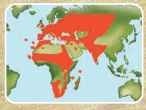
Lifecycle
The common quail is one of the most secretive of all gamebirds, and is rarely seen, even by birdwatchers. It lives most of its life hidden deep within dense vegetation.
HABITAT
The common quail is found from sea level to altitudes of 3,300′ or more, on level or gently sloping terrain. A bird of open country it favors dense, moist vegetation less than 3′ tall in which it can hide from predators. The common quail usually shuns shrub and woodland habitats, and this secretive bird also avoids bare ground. Sunny areas with light, well-drained soils of chalk, sand or peat are popular haunts.
The quail has adapted well to the spread of agriculture. It can be found in large fields of crops, especially winter wheat and clover but also oats, barley, rye, rape, lucerne, flax and meadow grasses.
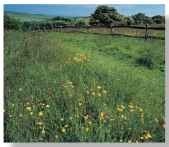
A Green and pleasant Areas with dense vegetation are popular quail breeding sites.
FOOD & FEEDING
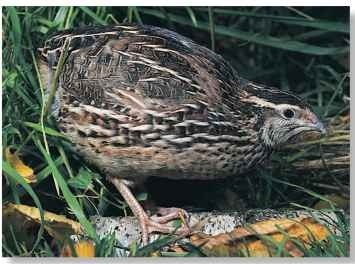
A Bark if you’re hungry Old timber is a source of invertebrate prey.
CONSERVATION
The common quail is heavily hunted, particularly along its migration routes, and is in decline across its range. It is also affected by drought, pesticides and changes in farming practices.
BEHAVIOR
Shy and wary, the quail spends most of its life among dense cover. Reluctant to fly even when disturbed, it usually goes unnoticed unless flushed from hiding. Startled in this way, a quail springs suddenly into the air, often giving a low trilling call. It flies fast and low before dropping down into cover. After the brief flight, the bird tends to run a safe distance, and effectively melts from view.
Despite its reluctance to fly, the common quail makes long annual migrations between its European breeding quarters and wintering grounds to the south of the Sahara in Africa.
Quake and quail one of the wariest of birds, the quail normally stays hidden in undergrowth.
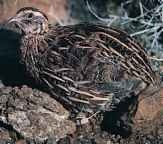
More than 100 species of food plant have been recorded in the quail’s diet. Staple foods include seeds of grasses, cereals and weeds, but the quail also eats beetles, bugs, ants, earwigs and grasshoppers, as well as spiders, snails and worms.
Animal food is important in spring and early summer, when seeds are scarce and females need as much protein as possible to prepare for breeding. The chicks probably bulk up on high-protein insects, too. Whether pecking at wind-scattered seeds or invertebrates, the quail feeds mainly on the ground. Sometimes it catches flies, ants and other flying insects by fluttering up to 3′ above the ground.
The name quail can be traced back to the Latin quaquila, which probably imitated the male’s distinctive call.
Across England, the quail has many quaint old local names, such as wet-my-lips, wet-my-feet and but-for-but. Other traditional common names for this bird include quailzie, throsher, deadchick and rine.
The quail is Europe’s only migratory gamebird.
BREEDING

A In her clutches The common quail’s nest is located in deep cover as its eggs are prized by many predators.
The male utters his loud, staccato call in spring and early summer to attract a mate. He is most vocal at dawn and dusk and generally silent once he has found a mate. Depending on the ratio between the sexes in an area, a female may mate with several males.
The female quail nests on the ground, in a shallow scrape lined with grass. In southern Europe, the first eggs are laid as early as April, but in the north, egg-laying begins later Clutch size ranges from 7-18 eggs. These are incubated solely by the female for up to three weeks. Clutches of more than 18 are probably laid by more than one female.
The striped downy chicks are well developed, leaving the nest within hours of hatching. Their mother may then lay a second clutch.
GAME, SET AND MATCH
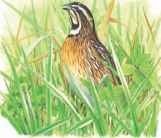
1 Cry out for attention…
Soon after arriving at the breeding grounds, each male utters his far-carrying call from deep within covei to attract a female.
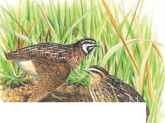
2 Playing on the wing…
When a female approaches, he circles her in a courting display, drooping a wing toward her or even trailing it along the ground.
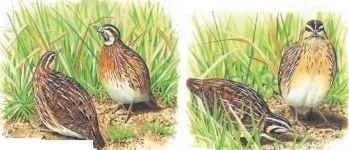
3 The food of love…
The male picks up food morsels and offers them to the female in the hope that she will respond to his overtures.
4 Sideshow temptation
If the female does not respond, the male runs toward her side-on, so that his profile will look larger and more impressive.
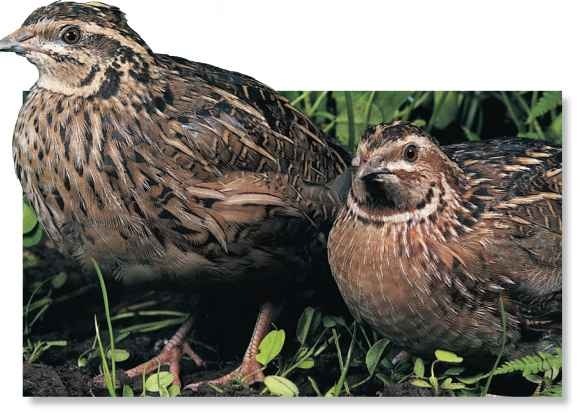
PROFILE
Common Quail
A tiny gamebird the size of a plump starling, the quail prefers to run and hide rather than fly, but manages to migrate great distances each year.
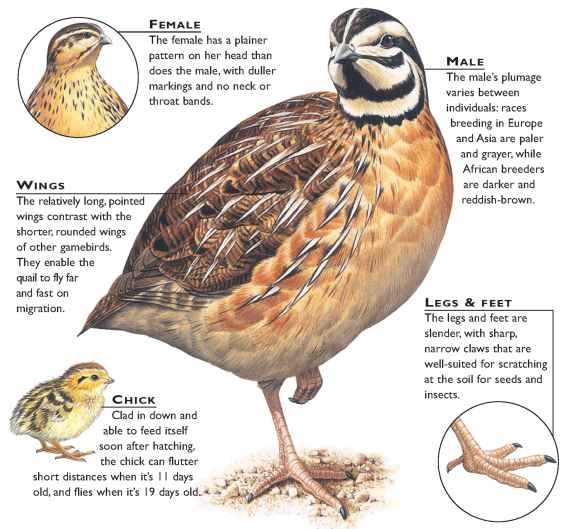
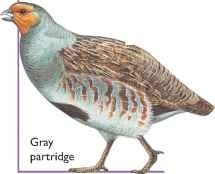
CREATURE COMPARISONS
The common quail can be confused with a young gray partridge (Perdix perdix). However the partridge lacks the quail’s bold head pattern, and in flight it reveals proportionately shorter, more rounded wings and a longer, broader tail.There is no confusing an adult gray partridge, distinct in plumage, and twice the size of an adult quail. Like the quail, the gray partridge feeds on seeds and invertebrates. It favors pasture or grassland and enjoys the cover of mature hedgerows. Although widespread across much of Europe and Asia, the gray^ partridge has suffered massive declines as a result of modern farming methods.
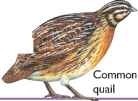
vital statistics |
|
| Weight | 2.5-5.4 oz. |
| Length | 6.4-7.2″ |
| Wingspan | 13-14″ |
| Sexual [ Maturity | 1 year |
| Breeding Season | Varies by location |
| Number of Eggs | 4-15, usually 8-13 |
| Incubation Period | 17-20 days |
| Fledging I Period | About 19 days |
| Breeding Interval | 1 year |
| Typical Diet | Wide range of plant seeds; also small invertebrates |
| Lifespan | Unknown |
Related species
• The common quail’s closest relatives are the 7 other species in the genus Coturnix. These . include the Japanese quail, C. japonica, the African blue quail, C. adansonii, harlequin quail, C. delegorguei, also of Africa, and the stubble quail, C. pectoralis, of Australia. Of the 7 families in the order Galliformes, the largest is Phasianidae, with 155 species of pheasant, partridge and quail.

